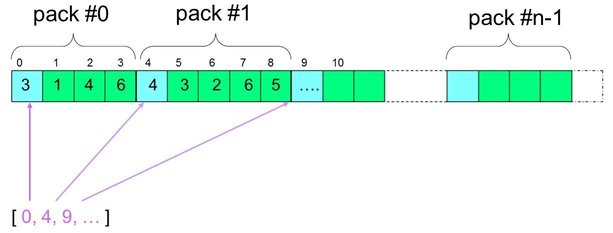Version: 8.3.0
The MED library make constant use of arrays of integer or double to represent the various data it needs. The arrays of integer (DataArrayInt) are of special importance as they often constitutes the return value of the functions provided by the API. This can be a list of nodes, a list of cells, a way to rearrange the cell in a mesh (a permutation), a part of the domain when doing parallel computation, etc ...
This page tries to cover all the form such a data can take and points to the most important functions available to convert from one format to the other.
Formally a "renumbering" is a mathematical application that can be surjective, injective or bijective. This application is defined using an instance of DataArrayInt. There are different ways to define this application.
The old to new mode is particularly recommanded for surjective and bijective applications. This is typically the case of MEDCouplingUMesh::mergeNodes method. Let's consider a call to mergeNodes that reduces the number of nodes from 5 nodes to 3 nodes.
In old to new mode the array MySurjection that specifies this surjection will have 5 tuples and 1 component. The content of the 5*1 values will be in {0,1,2}.
If MySujection equals [2,1,0,1,2], it means that :
This is the most common mode of renumbering in MEDCoupling because there is more methods implying renumbering that reduce the number of entities than method that increase number of entities.
Method in old to new mode that works on bijective applications :
Method in old to new mode that works on surjective applications :
Sometimes the format old to new for surjections can be replaced by another format with 2 arrays. Less compact in memory. The DataArrayInt::changeSurjectiveFormat method performs that.
The new-to-old mode is particularly recommended for strictly injective and bijective permutations. This is particularly useful for methods that increase the number of entities like for example MEDCouplingUMesh::simplexize.
All non static methods in DataArrayDouble or DataArrayInt having as last letter R (meaning Reversed) in capital works with the mode new to old. Let's consider a call to simplexize that increases the number of cell from 4 cells to 6 cells.
In new-to-old mode the array MyInjection that specifies this injection will have 6 tuples and 1 component. The content of the 5*1 values will be in {0,1,2,3}.
If MyInjection equals [2,0,1,1,3,0] it means that :
Method in new-to-old mode that works on bijective applications :
Method in new-to-old mode that works on surjective applications :
The indirect indexing format is made of two arrays of int (DataArrayInt) and is used to describe a set of groups (a group being here understood as a simple pack of int identifiers). Each group of identifier can for example represent a set of coincident nodes, or a set of nodes belonging to the same cell, etc ...

Denoting tab and tabI the two arrays of the indirect indexing format, we see at the top in the picture above the tab array, which contains n packs of identifiers (first pack is 3,1,4,6, second pack is 4,3,2,6,5, etc ...), and below the array tabI which provides the necessary offsets to extract a given pack from tab.
This format is widely used internally (this is how the connectivity of unstructured cells is stored for example), and is also returned by many functions, e.g.:
Some functions in the API to manipulate this format: